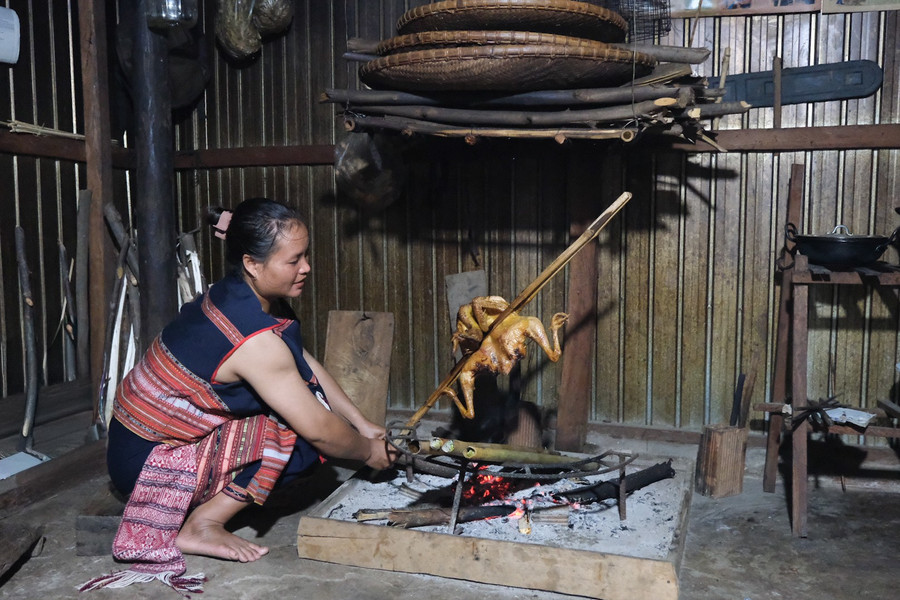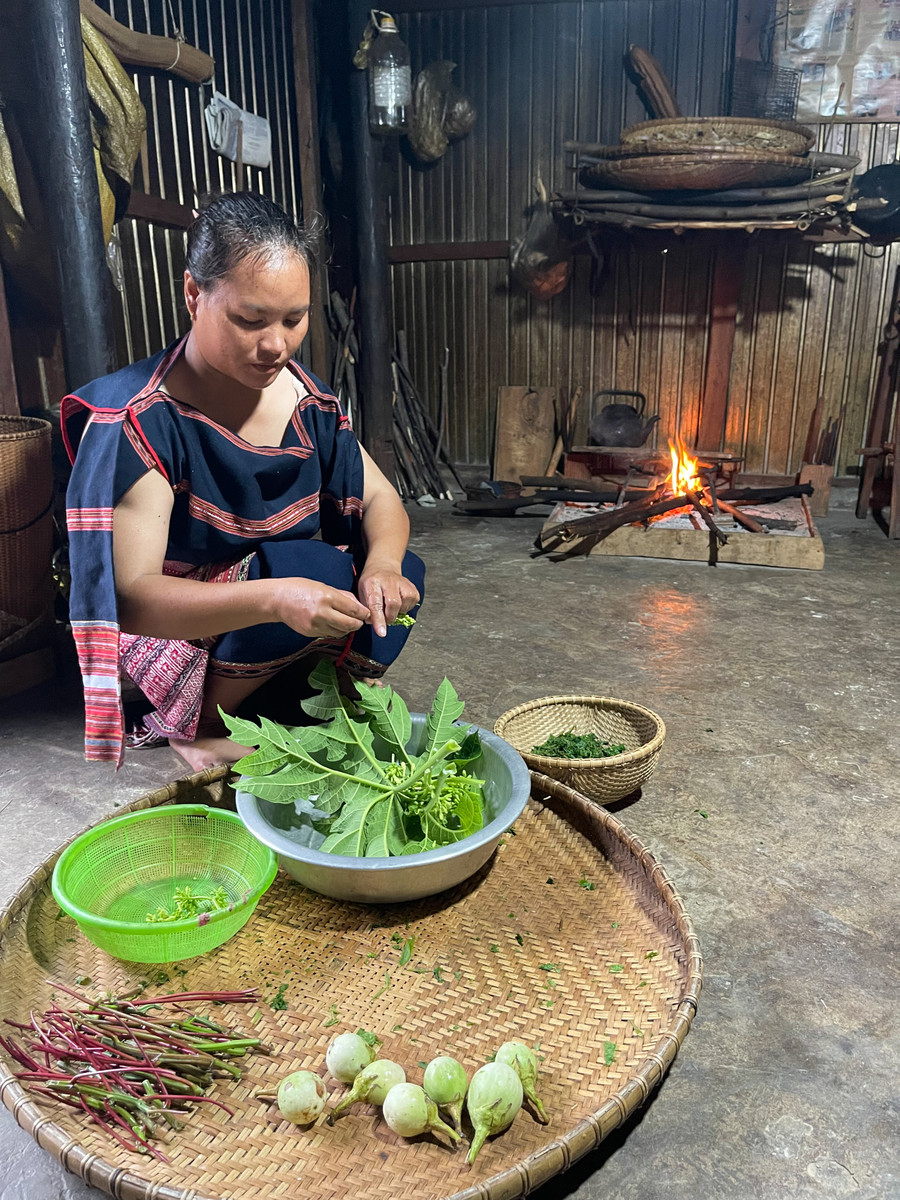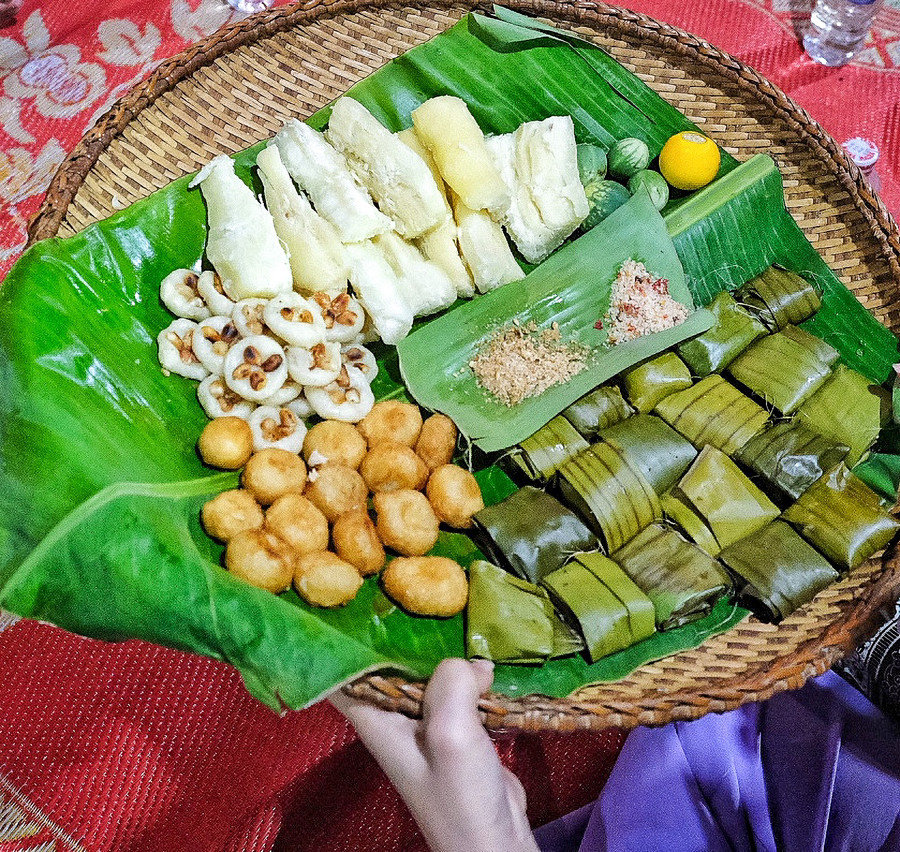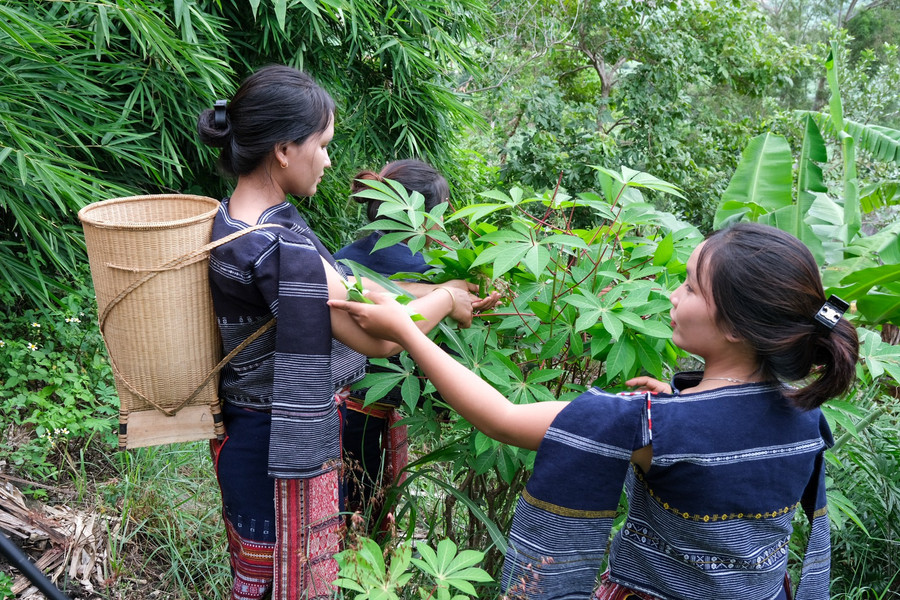1. On a rainy afternoon in Tơ Tung, mountain mist descends upon the stilt houses on the hillside. After a tour of the Stơr Resistance Village, Tơ Tung stream, and the Hero Núp Memorial House, the final destination for visitors remains the kitchen with its glowing fire.
There, the "delicacies of the human world" of the Bahnar people are revealed in a simple yet captivating way, encapsulating the spirit of "food is medicine, and medicine is food."

In the small kitchen of Ms. Dinh Thi Nhung's family (Stor village), the meal served to guests is made entirely from "homegrown" ingredients: free-range chicken, upland sticky rice, stream fish, wild turmeric flowers, bitter gourd leaves, and tơ pung - a dish of finely ground rice porridge cooked with chicken offal... The only industrial seasonings present are a little fish sauce and MSG.
Ms. Dinh Nhung, with her sturdy build typical of young Bahnar women, nimbly worked in the kitchen while smiling brightly: "Bahnar dishes are prepared simply, without elaborate marinades. The spices are mainly sourced from nature, such as lemongrass, turmeric, chili, and galangal... to preserve the purest flavor of the food."

Beside her, her husband, Mr. Dinh Moi, enthusiastically recounted stories of forest cuisine . He carefully held a few mountain snails—a gift from the forest, believed to have medicinal properties. He explained that mountain snails usually hide under layers of decaying leaves in the old-growth forest, their shells resembling the brown color of decaying leaves, and they feed only on the roots and leaves of medicinal plants. The snail meat is crunchy, subtly scented with herbs, and has a slightly bitter taste, but is very good for health.
Dinh Moi introduced the benefits of a delicacy gifted by the ancient forest: " Anyone suffering from bloating or indigestion will feel better immediately after eating it. Those who spend a lot of time in the forest will also experience less aches and pains in their joints after eating this snail. For that reason, the Bahnar people also call it medicinal snail. In the Eastern Truong Son Mountains, there is even a season for 'hunting' mountain snails from July to October every year . "
Visitors enjoy the food alongside a glass of ginseng-infused wine—a product of the Kbang mountains—enhanced by the host's murmured storytelling. The pungent spiciness of the wine, the unique flavor of the medicinal snails, and the tofu made everyone feel euphoric, as if they were attending a forest feast that money couldn't buy.
Born amidst the Trường Sơn-Tây Nguyên mountains, Nhung understands the culinary traditions intertwined with the seasons and the rhythm of life in the mountains. “The forest provides seasonal food for the people: bamboo shoots, rattan shoots, wild turmeric flowers… Only what the people don’t consume completely are sold or exchanged,” she says.
2. Leaving the hearth in Stơr, the culinary journey in Tơ Tung continues at Mơ H'ra-Đáp Community Tourism Village. Here, a type of tuber once used by the Bahnar people to ward off hunger has become a "welcome specialty"—cassava cake. The local cassava variety has a fragrant, nutty flavor; boiled and eaten with chili salt or peanut salt, it's already delicious. But the locals have also created unique variations.

Village elder Dinh Hmưnh recounted that eating boiled cassava all the time became tiresome, so the villagers came up with a way to grind steamed cassava into a sticky paste, which they then used to make various kinds of cakes: crispy fried cassava balls; small "bare-bodied" cakes similar to rice cakes, filled with roasted peanuts; and steamed cakes wrapped in banana leaves.
Many tourists are amazed when they experience how this incredibly simple cake is made, yet it delivers a uniquely delicious flavor. The rich, creamy taste of the cassava cake, served with chili salt and bitter eggplant—a small, egg-sized wild eggplant with a distinctive bitterness—is truly sublime.

Elder Hmưnh explained: “ Cassava is familiar to the Bahnar people, so eating a lot is fine, but it can easily cause indigestion in strangers, sometimes even 'cassava sickness. Bitter eggplant helps soothe the stomach and enhances the flavor.” Indeed, the slightly bitter taste of the eggplant, combined with the sweet and savory flavor of the cake and the spicy kick of the chili, creates a unique taste found only in the mountains.
After serving many tourist groups with simple, uniquely flavored cassava cakes, the locals have introduced a new type of cake combining cassava flour with grated coconut and coconut milk. This type of cake is easily found at street vendors in the city. However, it seems that only when tasting it in the Bahnar village nestled in the Truong Son mountains, with its indigenous cassava variety preserved through generations, can one truly appreciate the difference of this dish.
The cuisine of Tơ Tung embodies a thousand-year-old cultural heritage. In the bitterness of bitter melon, the crisp sweetness of medicinal snails, or the chewy texture of cassava, there is a way of life in harmony with nature, relying on the forest as a source of sustenance and also as a place to encapsulate the philosophy of health and longevity.
These simple dishes not only satisfy the hunger of visitors but also evoke layers of cultural memories and folk knowledge accumulated over millennia. And perhaps, it is this blend of rustic charm and profound wisdom that has made Tơ Tung an unforgettable culinary destination along the Eastern Trường Sơn mountain range.
Source: https://baogialai.com.vn/my-vi-tu-rung-o-to-tung-post566647.html


![[Photo] Prime Minister Pham Minh Chinh presides over a meeting on private sector economic development.](/_next/image?url=https%3A%2F%2Fvphoto.vietnam.vn%2Fthumb%2F1200x675%2Fvietnam%2Fresource%2FIMAGE%2F2025%2F12%2F20%2F1766237501876_thiet-ke-chua-co-ten-40-png.webp&w=3840&q=75)

![[Photo] Prime Minister Pham Minh Chinh presides over the conference announcing the establishment of the International Finance Centre in Vietnam.](/_next/image?url=https%3A%2F%2Fvphoto.vietnam.vn%2Fthumb%2F1200x675%2Fvietnam%2Fresource%2FIMAGE%2F2025%2F12%2F21%2F1766309817714_ndo_br_dsc-3400-jpg.webp&w=3840&q=75)




































































































Comment (0)